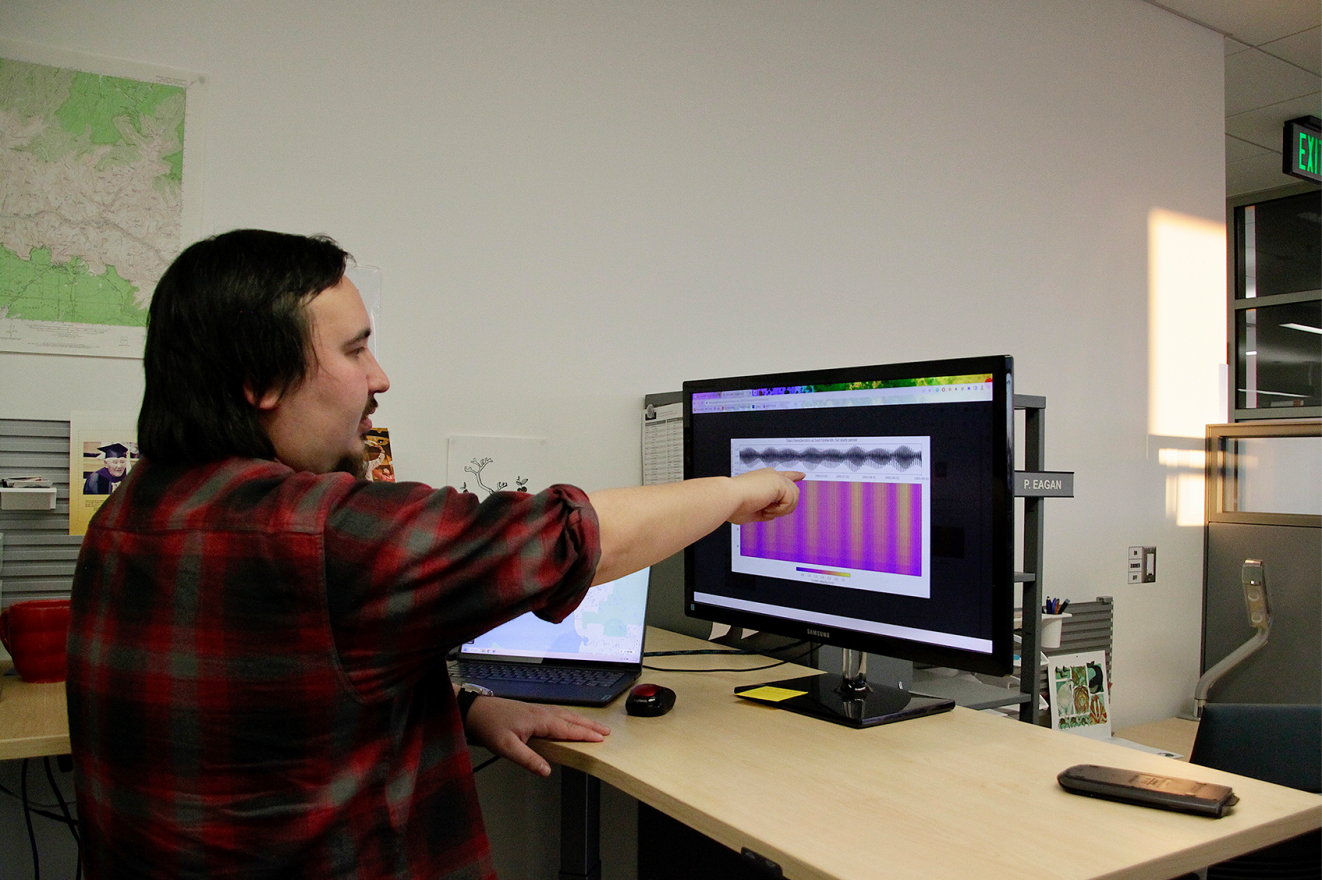
Bax Bond at his workstation. (Shondiin Mayo)

Bax Bond at his workstation. (Shondiin Mayo)
A photographer, biker and dry cabin dweller, Bax Bond comes from a long line of Indigenous existence. He is Yupik from the community of Tununak, Alaska which is located on the southwest coast of the state. He continues to be a lifelong resident as he lives in Fairbanks, working as a research engineer at the Alaska Center for Energy and Power (ACEP).
As an engineer he focuses both on energy balancing models, as well as marine energy in the arctic and heating. This field of work aims to develop energy systems for non-integrated electric grids and their associated oil-based heating systems. This work encompasses rural communities such as the one where Bond is from and overall, he joins a broader effort to seek possible energy solutions for Alaskans and beyond.
“Rural communities are often disproportionately affected by prices that they don’t have control over such as the price of fuel,” Bond says. “The highest price I’ve personally seen was $12.00 gallon for gasoline and small price increases or what most of urban America sees as small price increases those are often exponentially growthed (sic) out to rural communities,” Bond says. Asides from his current career, Bond’s creative outlet and knowledge can also be found on social media like his TikTok account, @thatoneyuk, where he speaks on energy and how it’s used in the Arctic.

Although his work is mostly contained in data sheets, numbers and equations, his ancestral ties to the land, and the lifelong connection to his Indigenous identity make this work important. By looking at different communities along the coast of Alaska, he makes the determination of, “…whether or not if (the communities) would be a good candidate for something like wave or tidal energy and determining what size of technology would work for that community.”
Bond continues to explain that much of this decision-making entails energy balancing modeling, as he usually receives data, “….from a community looking at their need versus what’s available to them in renewable energy resources such as solar, wind, wave, anything else.” With this amount of responsibility and community trust that is placed into Bond’s hands, it’s his unique approach to STEM that allows him to navigate this space.
Bond describes this method as being a community focused STEM approach “…that includes being mindful of listening to whatever community that we’re working with, making sure that we don’t make uninformed assumptions.” Much like Indigenous communities elsewhere, this is strongly reinforced when cultural sites and traditional gathering areas are brought into the picture.
This also includes being aware of the Indigenous knowledge that people in the area have, as this form of expertise represents the ancestral ties to the land. Bond puts it this way: “I view it as Indigenous people were doing science before it was formalized. What my job is now I’m doing all the formal things. I am finding the efficiency of this turbine given these flow parameters those are even standardized. I have to follow a certain equation.”
With the onset of Western Knowledge, Indigenous people have formalized their own form of knowledge by its ancestral tongue. Bond defined it as “word of mouth and by trusting what the elders say to do, because they learned from their elders and that knowledge has been tried and trusted and true over thousands and thousands of generations.”
The second part of this method also includes the community itself as they belong in the process as well. By adding different but impactful perspectives to each project, people, such as community leaders, can express what they know from their lived experience. Bond explains that they, “…know so much more about their community then we do, and they can give us feedback. We know all the science and math, we know things like power factor, and we know things about efficiency, but the ultimate goal is for the community to benefit the most with both of our shared knowledge bases.”
It’s this communal approach to energy development in rural communities of Alaska that will go farther than any imposed climate solution that doesn’t include the people living in that particular area or have traditional ties to.
Both the environment and people benefit from this approach as communities have the possibility to enjoy a reduced cost of living. Bond references a study that was completed on a “…community in southwest Alaska where individuals reduced their spending on heating fuel. Because of a thermal battery technology, they were able to spend more time and more money living a more traditional gathering lifestyle.” He continued to explain, that they were “…able to go out berry picking or go out hunting more and living in a way that aligns with their cultural values.”

This is most important when climate change is “…changing the energy environment that people live in,” said Bond. “It’s changing the way resources are up here.”
Because climate change is so heavily researched by Western science, which has experienced continued reinforcement of Indigenous Knowledge, the phenomena, at its core, can bring people back to their universal values.
As Bond says, “We have what’s important to us. Many Indigenous people have very strong cultural values. We should be able to live out those cultural values, right? One of those things that impede people’s cultural expression is cost of living. Why does it matter? Shouldn’t we try to make our lives and other people’s better? Shouldn’t things get easier as our humanity ages? And that is based on the fact that we should care for other people. At the end of the day, we should care for other people just as much as we do for ourselves and our family.”